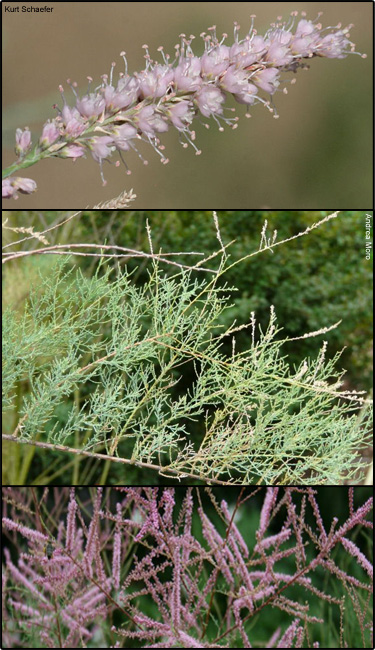Saltcedar (Tamarix ramosissima)
 Description: It is extensively established in the southwestern United States and Mexico. Believed to have been introduced on the East Coast in 1823 as an ornamental.
Description: It is extensively established in the southwestern United States and Mexico. Believed to have been introduced on the East Coast in 1823 as an ornamental.Habit: Deciduous, long lived (50-100 years) shrub or small tree growing 5-30 feet in height and forming dense thickets.
Leaves: Compound, alternate, scale-like and tightly overlapping along the stem.
Stems: Slender, light red, or orange-yellow and weeping when young. Older bark is grey.
Flowers: Pale pink to white dense plumes that blookm from early spring to late fall.
Fruit and seeds: Fruit capsules contain numerous tiny (1/25 inch diameter) seeds.
Habitat: Native to Eurasian and Africa. Found in disturbed and undisturbed streams, waterways, bottomlands, banks and drainage washes of natural or artificial water bodies, moist rangelands and pastures. Capable of growing in soils containing up to 15,000 ppm soluble salt.
Reproduction: By root expansion, resprouts and by seeds that are dispersed through the air and by water.
Monitoring and rapid response: Hand pulling, digging, root-cutting, and the use of hand tools is recommended for small infestations. Fire has been used, but saltcedars are fire-adapted and readily resprout. Can be effectively controlled using any several readily available general use herbicides such as glyphosate or triclopyr. Credits: The information provided in this factsheet was gathered from the U.S. Department of Agriculture, Forest Service.
Individual species images that appear with a number in a black box are courtesy of the Bugwood.org network (http://www.invasive.org). Individual photo author credits may not be included due to the small display size of the images and subsequent difficulty of reading the provided text. All other images appear courtesy of Google (http://images.google.com).
Common Name: | Saltcedar |
Scientific Name: | Tamarix ramosissima |
Family: | Tamaricaceae (Tamarix) |
Duration: | Perennial |
Habit: | Shrubs |
USDA Symbol: | TARA |
